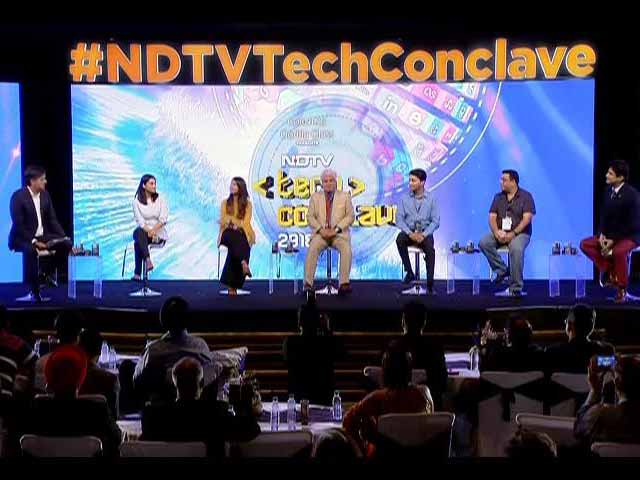How Technology Is Reshaping The Fitness Industry
Technology in fitness has become important in today’s life because of the concern of excessive physical inactivity amongst all of us
Conclave Highlights | Written By: Dr. Rajat Chauhan | April 26, 2018 8:58 AM

While speaking at the Technology Conclave on April 13, Dr. Rajat Chauhan, Sports-Exercise Medicine & Pain Management Physician and Author, said that he is excited about technology in fitness but he is not yet celebrating. It isn’t there yet. “Today there is a lot more talk about getting physically active but we are lot less physically active than ever before. Paradoxically, previous generations were not talking so much about being physically active but were actually more active,” he said.
How technology is reshaping the fitness industry
Technology in fitness has become important in today’s life because of the concern of excessive physical inactivity amongst all of us. Technology helps us have a far wider reach and access. The problem is that too much information has diluted the quality as anyone and everyone has an ‘expert’ advice. There is almost no way to find out their credibility.
Wearable fitness technology has become available to a lot more people today’s because of the costs coming down too, besides knowing more about their uses and benefits courtesy the information that is readily and easily available.
As much as there is increased awareness and availability of the wearability technology, just knowing the benefits and wearing the technology is not going to do anything. You’ll have to do something with technology for the results to show. Recent studies repeatedly are showing that wearable technology is failing to make people any fitter.
Wearable technology is throwing out too much but there is no one out there making sense of all that data. Call to action is simply missing.
Trends of fitness technology
Technology in fitness has made the big sports companies to start shifting their focus as brand ambassadors from elite to recreational participants who have are very active on social media with high numbers of fans. It is trend that is visible across the board.
Fence sitters and amateur active people can relate more to these recreational participants who are very active on social media. They could be their friends from their running groups, from their own gyms or a story like their own. They can aspire to be like them. They want to wear whatever these amateur participants are wearing as the message sent out, very subtly so, is that those wearable technologies have made them as fit as they are. Whereas, elite sports people seem like demigods who they only read about in newspapers and watch on television. They simply can’t see the connect. It was recently reported that Under Armour has been losing ground to its competitors because of delay in this move. So it definitely is a smart business move.
It isn’t as if nothing good has happened for the society because of technology in fitness. Technology has helped personalise training plan based on gender and age. Today a lot more ladies, who earlier over generations had been told to not move because it’s not lady like, have started participating a lot more. There are connected better with each other and encouraged by other ladies who have picked up gym, running or other sports before them. It helps that wearable technology is becoming more specific to them.
We are suddenly seeing emergence of masters (over 40-45 years) athletes and sports people who are starting to excel to pretty decent levels in their chosen sports. Earlier, it was often told by doctors to people in their mid 30s and beyond, to stop playing sports, otherwise they would develop arthritis. Others would say, ‘why play sports if you don’t want to go to Olympics.’ You still hear such things, but a lot lesser.
There might be too much information out there and confusion because of contradictory advice on any fitness or sport or nutrition, but there finally is a consensus that sugar isn’t good for you. We’ve known that for decades but now everyone knows about it and people have started taking action on it. Anti-sugar movement has really taken off. This is all courtesy technology.
The sudden increase of wearable in the market – the takers for these kind of wearables today
50 million wearable gadgets are to be sold in 2018. All big companies seem to be involved in this business. It might surprise you but Lenovo and Sony have already shut shop when it comes to wearable technology. It might be a temporary move but it shows that this space is too crowded and it’s not easy even though it seems very appealing.
Millennials and beyond have been sedentary pretty much from very early in life. They were pretty much born in the world of smart phones and tablets. Now not only them, but all of us are trying to outsource physical activity to technology as if technology is going to move and we’ll have the benefits.
Since I deal with back and knee pain, non-surgical and minimal medicine way, I would like to draw parallels. You wouldn’t believe but some folks with back and knee pains think that getting an MRI is going to make their problems go away.
We think we wear this watch or shoe and we will get fit, but it doesn’t happen. It’s proactive involvement that matters.
More than a quarter of running shoes that are bought are not by people who run. They are bought by people who find them cool and want to make a statement. The same is happening in other wearable fitness technologies too. Way too many folks have fitness watches for the same reason. Yes, that adds substantially to business but not necessarily to health and fitness.
Recent studies have shown that wearable fitness gadgets are good for ‘heart rate’ measurements but aren’t doing a good job when it comes ‘energy consumption’, something fundamental on which all their assumptions are based on as far as training programs go.
A good exercise is one that is done rather than the most technical one. Technology needs to be an enabler removing as many hurdles to exercising as possible. It’s on its way to doing this.
There has also been digital burnout. Sometimes you just need to go back to what makes you human. Go back to how you are feeling. I don’t need a machine or a watch to tell me how my heart rate is doing. Over years I have become more sensitive to what my body is doing. Anyone would become the same if they listen to the body. The simple trick is to go by how you are feeling, the ‘x’ factor missed by technology currently.
I have been recommending people to run at their breathing zones rather than heart rate zones. It is because breathing is directly connected with how you are feeling. You can pick your breathing rate, but estimating your heart rate is a lot more difficult. In any case, your breathing increases based on your effort, which is further related to heart rate in any case. I call it NukeLeeUs pacing.
Even in today marathons across the world Jones-Counter in cycle for standard course measurements, and not GPS technology. All runners would agree that all different brands of GPS watches have a disagreement of varying degrees when it comes to measuring distances.
All these problems will soon get sorted, but right now they it’s still work in progress as far as technology in fitness goes.
How young is too young to start with tech and fitness
When we are born, no one teaches us to breathe, hear, see, touch, smell and taste, all of which are important senses which make us what we are. It’s our basic instinct as humans. To think and feel. No, technology hasn’t replaced them yet.
Technology is useful in fitness but let’s not try to rush it and try replacing these very fundamental senses and feel. These are the x factor.
Yes, a technology as simple as a shoe was done with best intentions whenever way back in time humans figured them, but they now are back firing. More than a quarter of bones in the human body, are in the two feet and ankles. There are similar number of muscles, tendons and ligaments too. Their movement, stability and awareness in space is being managed by the nerves supplying them. There is a high density of nerve endings in the sole of our feet. If our feet weren’t supposed to have these high numbers of bones, muscles, tendons, ligaments and nerves, we would have only been given a few of them.
Wearing a shoe, numbs the highly dense nerve endings in the feet our soles. We suddenly don’t know how to respond to the ground. When that simple but basic perception is taken away, you’ve stopped your feet from thinking for themselves. Now they are dependent on what the rest of your body does.
What I am advising is not to start going to offices and schools bare foot, but to spare sometime in a day, especially at home to walk around barefoot and get those feet to spread out. Let them feel the ground. Spend 5-10 minutes a day walking around barefoot on the grass in the lawn.
Yes, we can’t run away from today’s lifestyle, but we can alter it just a little to get the best of both worlds. Get that feel back again.
I would suggest using technology in fitness for some things but not for all. It’ll otherwise dumb us sooner.
What can we expect in the future
I am keenly looking forwards to first us ‘experts’ deciphering what all the data being collected from wearable gadgets means and the personalised call to action. Formulae like ‘heart rate = 220 minus age’ maybe is ok for most, but not for all. How possibly can maximum heart rate be same for twins if they have led very different lives. We need technology to become very customised to each and everyone of us.
Same applies to nutrition. We are already talking about this in medicine where drugs would be given based on gender, race, weight, height, metabolic rate, feelings, intensity of physical activity the day before and what is to be expected today and tomorrow, external factors like weather, altitude etc. It’ll be wonderful to have the same be done for nutrition and hydration on a very regular basis for each of us.
10,000 steps is being used in a lot of wearable technologies as the gold standard as far as amount of exercise needed by us all in a day. It is a random number. These aren’t enough number of steps to keep everyone fit. It could be a good starting point but soon, in a month or two, you’ll need to do more. Remember a student in class one after some time is promoted to class 2. If not they remained in class 1 forever, they wouldn’t get any better any more. They would plateau off. Same applies to exercise. We have to keep pushing harder, slightly so each time. The aim is not to be better than anyone else, but better than our old self. The plan is to become the best version of ourself. To do justice to ourself. For that we need customised plans that understands our need better.
Wearable technology is already measuring your steps and calories burnt. It is attempting to measure and track both quantity and quality of sleep, indirectly looking at stress too. All these together with how you feel, will be able to guide how to improve your workout routine to to get the best results.
In any case, health and fitness is not limited to physical benefits, but mental and emotional as well. We weren’t happy, we are missing the whole point. I am not sure how technology will aid in that but it important for us to look at the whole spectrum and work on it.
Fitness and technology in fitness is a journey, and not a destination. And it is very important to keep that smile on, from ear to ear, for years to years. It is important that we always keep miling and smiling. Neither of which technology can do for us.
At the end of the day, technology is only a tool. It’s only as good or as bad as we make it to be. On it own, it’s nothing. At least, not yet.
Watch: How Technology Can Be Used To Achieve Perfect Fitness
Latest Videos
About Us
The NDTV Tech Conclave will be a congregation of leading minds in the technology, mobile and digital industry and will witness participation from several Indian and Global technology giants.








